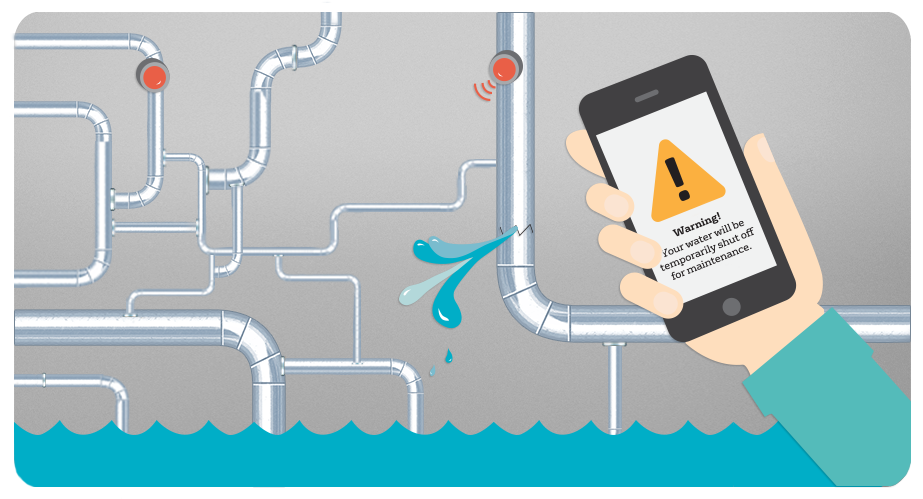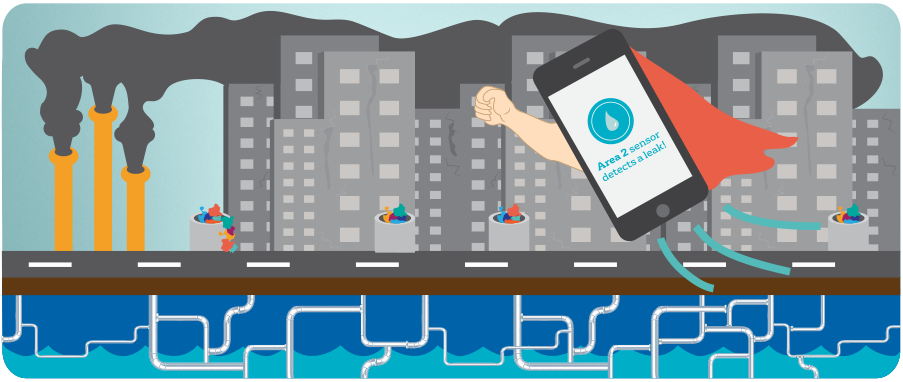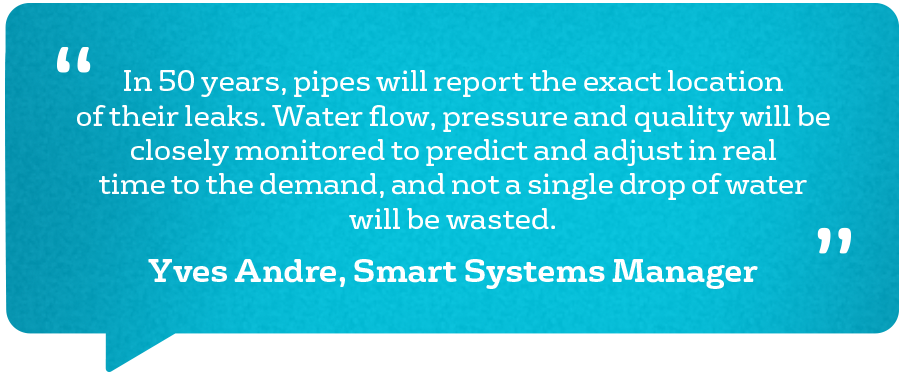
Creating intelligent water networks
How do you know when a water pipe at your property has sprung a leak? Is it when half your home is underwater, or when your smartphone tells you?
If you live in Lyon (France), it’s likely to be the latter.
In 2015, Lyon’s water network got a digital overhaul when Veolia introduced its Waternamics solution, bringing the city’s ageing water infrastructure into the 21st Century.
Developed in collaboration with IBM, Waternamics is making city water networks smart. The solution uses digital sensors to detect what’s happening within water networks, and to prevent small issues, such as leaks, from turning into big problems.
Waternamics at work
The Waternamics solution that Veolia developed for Lyon included the implementation of hundred of thousands of sensors throughout the water network – on water networks, and on pipes beneath the ground.
So now, if there’s a leak in the network, a sensor will detect it and send an alert to what you might call ‘mission control’, where data analysts are standing by to – you guessed it – analyse the data.

Based on what the sensors are telling them, analysts then send detailed instructions to the repair team as to what to pack in their toolbox, directions to the leak site, and even the best place to park – all in real time. And customers receive an SMS telling them that their water is about to be temporarily cut off, and when it’s back on, all before they’ve realised there’s a leak at all.
Digitisation of water infrastructure
Waternamics is an example of the digitisation of water infrastructure. This basically means collecting, processing, showing and analysing large volumes of data and using digital technologies, such as sensors and IoT communication infrastructure, to help people make smarter decisions about water supply. Without these kinds of systems, cities rely on customer complaints to trigger investigations into water issues.
As Yves Andre, Smart Systems Manager at Veolia, explains, there’s never been a better time to go digital.
“It’s now cheaper and more accessible than ever to use sensors, such as digital meters, water quality sensors and acoustic leak detection sensors. These instruments generate large amounts of information, giving us insights into what’s going on in the network, allowing us to move from a corrective to a predictive approach.”
And with growing challenges such as increasing urbanisation, greater pollution, climate change, and ageing infrastructure, there’s a real need for cities around the world to get up to speed with the digitised water revolution.
Lyon’s success story
Lyon faces many threats to its water supply. Climate change has led to more frequent freezing episodes and more burst pipes. The Rhone River – once a main source of drinking water in the area – has been polluted to the point of no longer being a sustainable water source. And when Veolia took control of operations supplying water to the Greater Lyon area, the city’s ageing infrastructure was experiencing around 400 leaks per year.
Like so many cities, Lyon can’t afford to let any of its precious water simply leak away. Veolia’s Waternamics solution for Lyon dramatically increased the performance of the network, improved the efficiency of field teams, and upgraded service levels to customers. It also led to a 25% reduction in water losses – a saving of 4.8 million cubic metres of water per year.
Appetite for change in Australia
The Australian water industry is also facing challenges of ageing infrastructure, population growth and climate change – especially increasing risks of drought and the resulting water scarcity.
In response, a number of cities are using digitisation of water infrastructure – or smart water solutions – to bring benefits to customers, and to create efficient water networks for the future.
For example, the Mackay Regional Council in Queensland has introduced automatic water meter readings to empower customers to better manage their water consumption and save money.
The digital meters will also alert customers and local authorities to leaks. With the majority of the city’s water infrastructure under the ground, leaks and faults are usually not identified until they have caused a major problem. Having the technology will allow local authorities to repair the issues within a much shorter timeframe, reducing water wastage.
And in Melbourne, to meet the challenges of climate change and more extreme droughts, three local water utilities are investigating digital water meters.
The new technology will help customers control and even be totally informed on their water consumption. This has the potential to provide Melburnians with a greater level of certainty about the reliability of their water supply in a time of climate uncertainty.
The future is digital
Rapid population growth, urbanisation, pollution and climate change, all threaten our cities’ water supplies. But smart water solutions powered by digital technologies could put us in control of every possible leak – and every drop of water.

Yves Andre says: “In 50 years, pipes will be smart enough to report the exact location of their leaks. Water flow, pressure and quality will be closely monitored to predict and adjust in real time the demand. The dream is to not waste a single drop of water.”
So next time you leave a tap running, or there’s a leak below your floorboards, don’t be surprised if your smartphone is the first to tell you.

